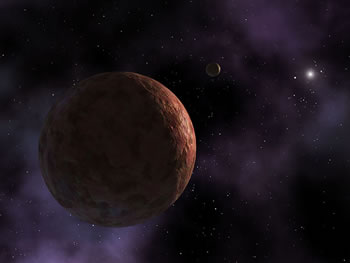Science Fiction
Dictionary
A B C D E F G H I J K L M N O P Q R S T U V W X Y Z
Massive Planetoids From Beyond The Solar System

New calculations reveal that large planetoids may have formed hundreds of times farther from the Sun than previously thought. One such object, Sedna, discovered in 2003, is close to the size of the outermost planet, Pluto.

(From Artist's concept of Sedna (NASA))
Stern's work is the latest in a series of speculations by scientists to try to explain the find. Some believe that Sedna is a Kuiper Belt object (formed within the orbit of Neptune); others believe that Sedna is an inner Oort cloud object. Scientists have also advanced the theory that Sedna was not created in this solar system at all, but was pulled from a passing star early in the formation of the solar system.
The idea of a planet that passes from star to star has also been explored in science fiction. In his excellent 1977 novel Dying of the Light, George R.R. Martin writes about a world named Worlorn, a rogue planet discovered by the race of Man in the distant future. When the path of the object was plotted, it was clear that it would make a single close approach to the Hellcrown, a multiple star system. Fifty standard years of sunlight would briefly warm this wandering world, the venue for the greatest festival ever held...
There was a century of storms as Worlorn neared the light: years of melting ice and volcanic activity and earthquakes. A frozen atomosphere came, bit by bit, to life and hideous winds howled like monster infants. All this the outworlders faced and fought.The terraformers came from Tober-in-the-Veil, the weather wardens from Darkdawn... The men of High Kavalaan supervised it all, since High Kavalaan claimed the rogue... At last Worlorn was gentled. Then cities rose, and strange forests flowered ... and animals were set loose to give the planet life.
In ai-589 the Festival of the Fringe opened.. On that first day the Toberians let their stratoshield shimmer, so the clouds and the sunlight ran and swirled in kaleidoscope patterns. Other days followed, and the ships came...
(From Dying of the Light)
Martin creates a great story of lost love and changing cultures in the novel; Dying of the Light was reissued last year in paperback, and I highly recommend it.
Read more about new work on Sedna at Solar system planetoids could be really far out; read more about Sedna at Space.com. See Stay star may have jolted Sedna for alternative views on the formation of distant planetoids.
Scroll down for more stories in the same category. (Story submitted 1/25/2005)
Follow this kind of news @Technovelgy.| Email | RSS | Blog It | Stumble | del.icio.us | Digg | Reddit |
Would
you like to contribute a story tip?
It's easy:
Get the URL of the story, and the related sf author, and add
it here.
Comment/Join discussion ( 6 )
Related News Stories - (" Space Tech ")
Will Space Stations Have Large Interior Spaces Again?
'They filed clumsily into the battleroom, like children in a swimming pool for the first time, clinging to the handholds along the side.' - Orson Scott Card, 1985.
Reflect Orbital Offers 'Sunlight on Demand' And Light Pollution
'I don't have to tell you about the seven two-mile-diameter orbital mirrors...'
Chrysalis Generation Ship to Alpha Centauri
'This was their world, their planet —
this swift-traveling, yet seemingly moveless vessel.' - Nat Schachner, 1934
The First Space Warship For Space Force
'Each of the electrical ships carried about twenty men...' - Garrett P. Serviss, 1898.
Technovelgy (that's tech-novel-gee!) is devoted to the creative science inventions and ideas of sf authors. Look for the Invention Category that interests you, the Glossary, the Invention Timeline, or see what's New.
Science Fiction
Timeline
1600-1899
1900-1939
1940's 1950's
1960's 1970's
1980's 1990's
2000's 2010's
Current News
iPhone Air Fulfils Jobs' Promise From 2007 - A Giant Screen!
'... oblongs were all over the floor and surfaces.'
ChatGPT Now Participates in Group Chats
'...the city was their laboratory in human psychology.'
iPhone Pocket All Sold Out!
'A long, strong, slender net...'
Did The Yautja Have These First?
What a marvel of ingenuity the little device was!
Jetson ONE Air Races Begin, Can Air Polo Be Far Behind?
'If you're one of those rarities who haven't attended a rocket-polo "carnage", let me tell you it's a colorful affair.'
Will Space Stations Have Large Interior Spaces Again?
'They filed clumsily into the battleroom, like children in a swimming pool for the first time, clinging to the handholds along the side.'
Mornine Sales Robot
'Robot-salesmen were everywhere, gesturing...'
Bipedal Robot Floats Gently While Walking
'a walking balloon proceeded with long strides of its aluminum legs...'
Musk Idea Of Cars Talking To Each Other Predicted 70 Years Ago
'My cars talk to one another.'
Elegant Bivouac Shelter Produces Water And Electricity
'There was nowhere on the planet where science and technology could not provide one with a comfortable home...'
X-Control Janus-1 A Suitcase Aircraft
'You will notice that it... fits the suitcase nicely.'
'AI Assistants' Are Actually Less Reliable For News
'Most men updated their PIP on New Year's Day...'
YES!! Remote Teleoperated Robots predicted by Technovelgy!
'...a misshapen, many-tentacled thing about twice the size of a man.'
Will Robots Ever Fold Landry?
Where have you gone, Mrs. Robinson?
Will AIs Give Better Results If You're Rude To Them?
'I said, "Listen up, motherf*cker.'
Cybertruck Robotic Arm F10 Drone Launch!
Drone away!
